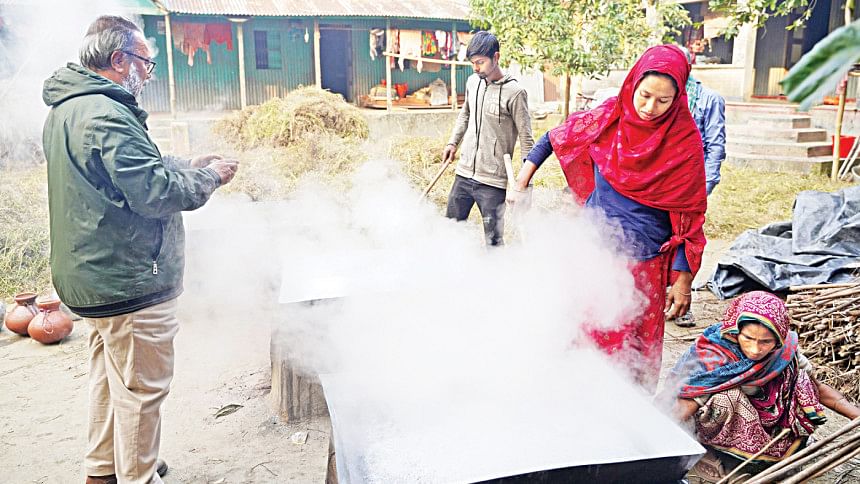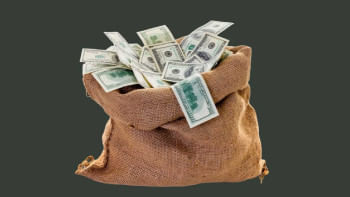The legacy of Hajari gur

It was half-past three in the morning when we started for Manikganj a month ago. The vehicle we were travelling was moving slowly as the entire highway to Manikganj was covered with thick fog. You have seen my documentary on Hajari gur, molasses, in 2017. This time I visited Manikganj to see the development in production and market of Hajari gur. Hajari is an asset for the people of Manikganj as it is a legacy carried by locals for centuries. I always thought Hajari gur should be brand-named and former Manikganj municipality mayor Gazi Kamrul Huda Selim took the initiative in this regard.
After five years, I was travelling to Shikderpara in Jhitka, located under Harirampur upazila, to see the current scenario of Hajari gur. It was half-past five when I arrived there and went straight to meet Sohrab Hajari. Sohrab has been involved in producing Hajari molasses for generations. I heard Sohrab's son Mizanur Rahman while he was extracting juice from a date tree. "The juice is not the same as before, probably, due to the climate change," Mizanur said. Unfortunately, the quantity date juice has decreased a lot over the years, he said. There was no time to waste. They started the boiling process as soon the date juice is poured on the square metal tray. All the family members are involved in making the molasses. They used to boil the juice on earthen pots in the past.
Locals said a few centuries ago, a man named Hajari Pramanik of Jhitka first made the exceptional molasses. It became so famous, thus, from then on, locals started calling it Hajari gur, molasses. Mizanur's mother Khadija Begum, who was also helping the process, got involved in making the very special Hajari gur since her marriage. She has been doing it restlessly, with utmost care and purity, for more than 50 years now. While talking, Mizanur narrates the technique of making Hajari molasses. After boiling for 25 minutes, the juice reaches a perfect thickness. White Hajari molasses is prepared in the square metal pot with continuous labour.
I had a walk in the locality and found about 20 specific families of the area are engaged in making Hajari molasses. While walking a little further, I met Ziarat Ali, who is known as a big Hajari molasses producer. There are about 400 date trees under his ownership and he is producing the item at a large scale. The prerequisite of quality juice depends on the health of the date tree. After extracting the juice they have to wait for five days to let the tree get prepared. Besides, they need a clean pot and the boiling process has to be handled by a few workers at a time. The tasks include hard work, dedication and caution. If there is a fall in the rhythm of the work process, they won't get the desired and proper Hajari gur. Ziarat produces 20 to 40 kilograms of Hajari gur. After completing the boiling process labourers pour it on a fresh cloth to give it a shape. The process has been continuing for the past 250 years or more.
With a dedication to protect the purity of Hajari gur, Shamim Hajari is associated with the tradition. He said, "I am the sixth descendant of Hajari Pramanik. I didn't thought about it much, but after watching one of your reports on Hajari gur in 2017, my eyes opened." Shamim Hajari, who is involved in maintaining the purity of Hajari gur, also has a trademark license. Then, I went to Jhitka Bazar, popularly known as Hajari gur market, to see the molasses price. Shamim regularly monitors the market that has specific wholesalers. However, Hajari molasses is more expensive than the other available molasses. And, if one try to sell adulterated molasses, he gets caught in the monitoring process. Hajari gur cannot be compared with other conventional molasses, because efforts for hundreds of years ensure its unique production process. In the age of globalization and urbanization, many traditions of rural Bangladesh are fading away, but Hajari gur has survived due to the sincerity of some tradition-lovers of the remote villages in Manikganj. It is our responsibility to preserve the heritage of Bengal.
Dear readers, traditional Bengali culture became enriched with taste, pleasure and love. I expect, the government, as well as private entrepreneurs, will extend cooperation to preserve the heritage.

 For all latest news, follow The Daily Star's Google News channel.
For all latest news, follow The Daily Star's Google News channel. 



Comments